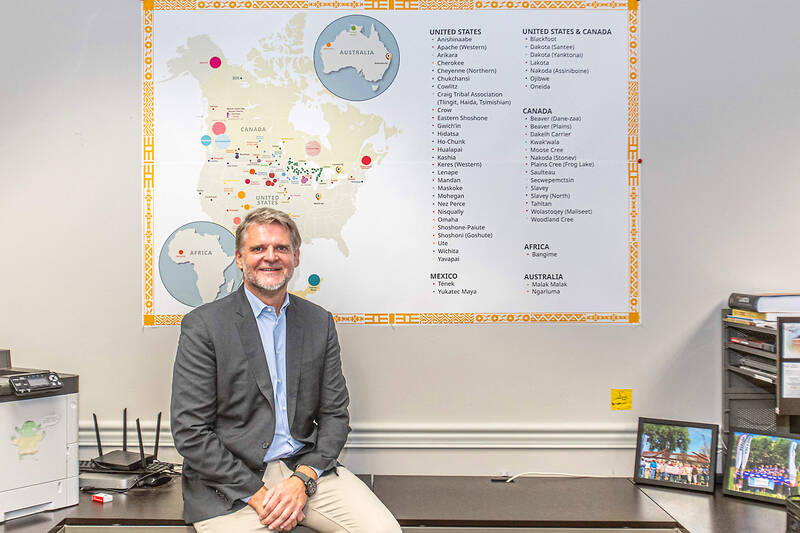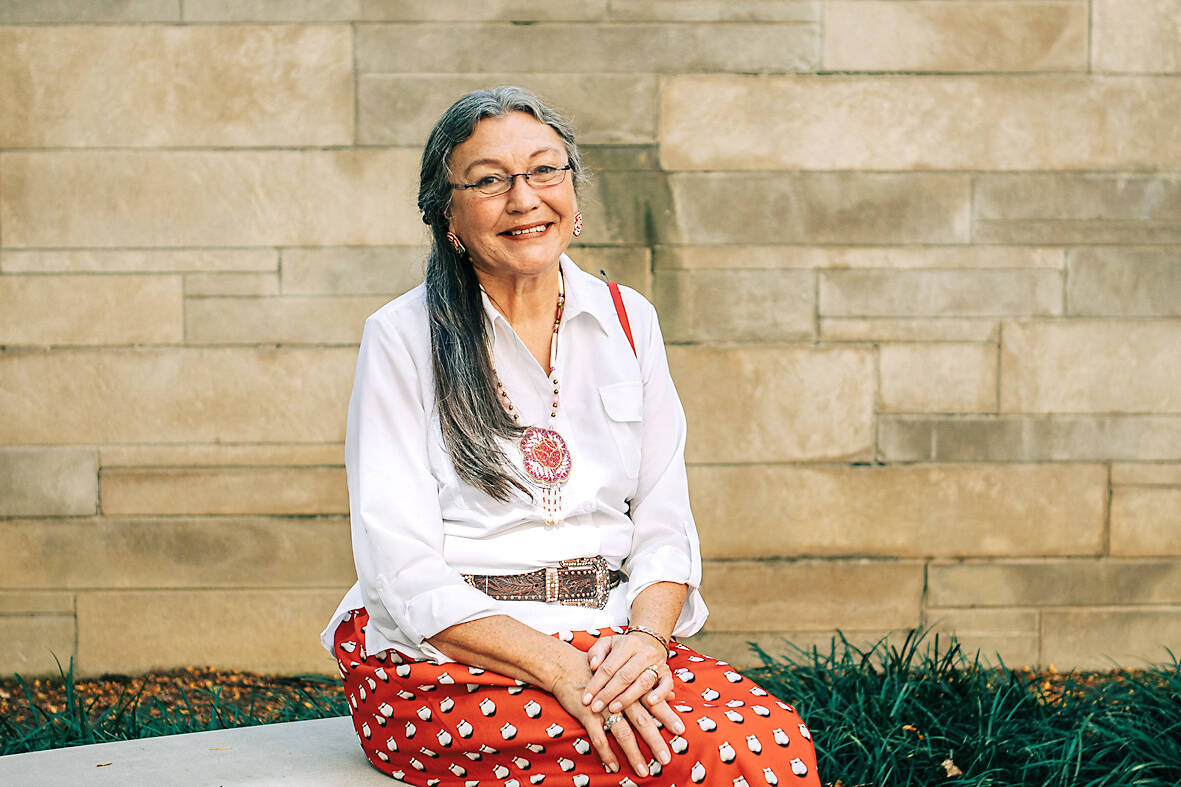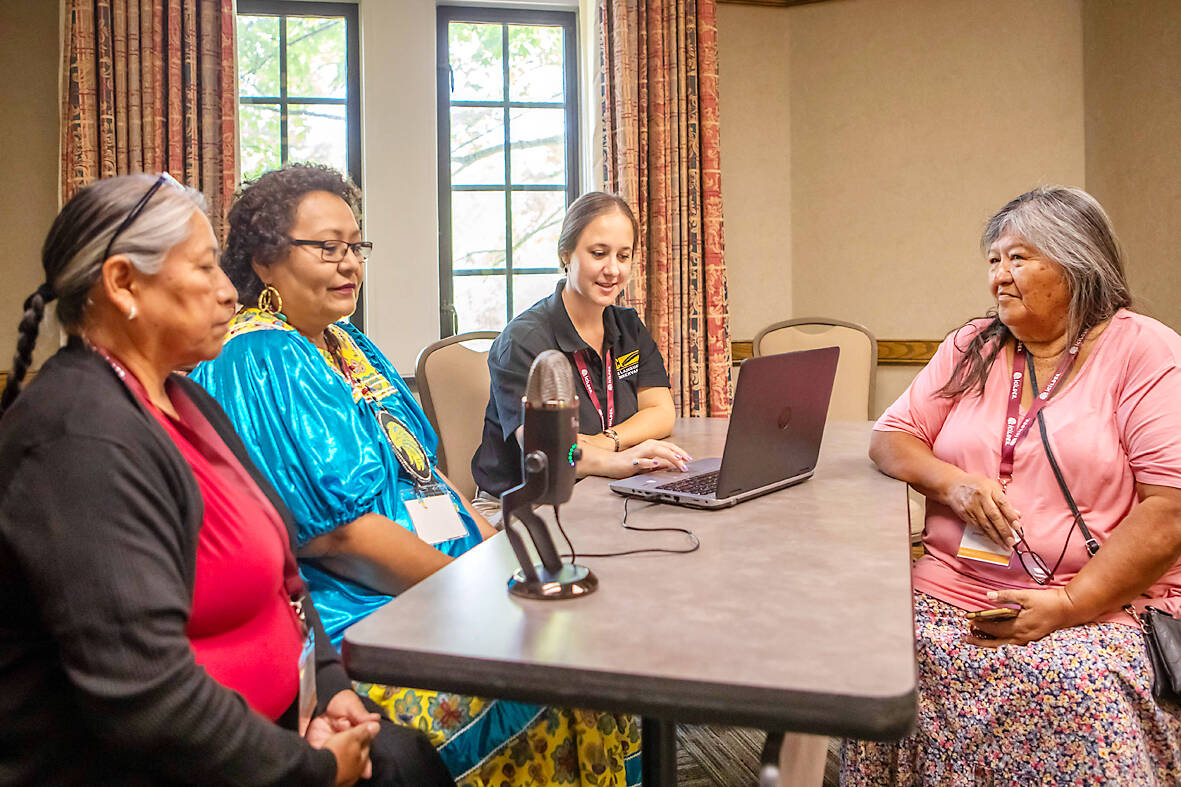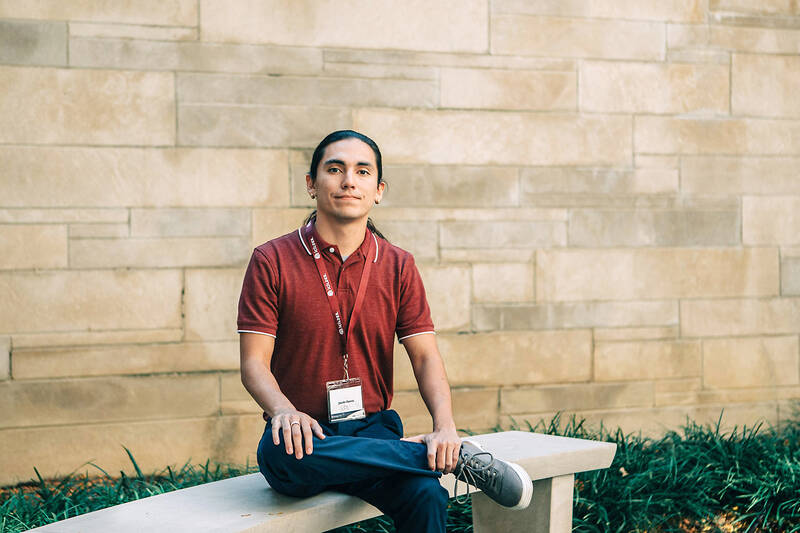Linguistics experts are turning to cutting-edge technologies to revitalize threatened Native American languages — and rejuvenate generations of indigenous tradition — through new approaches such as children’s books and smartphone apps.
In one such endeavor, three Native American women rack their brains as they gather around a computer, trying to remember — and record — dozens of Apache language words related to everyday activities such as cooking and eating.
They are creating an online English-Apache dictionary, just one of several projects working to preserve endangered indigenous languages in the US.

Photo: AFP
The women are working with Rapid Word Collection (RWC) software, which uses an algorithm to search Apache text and audio databases for so-called forgotten words.
The words are then defined, translated into English, and their pronunciation recorded, so the dictionary’s users will know how to say them properly. Teacher Joycelene Johnson and two of her colleagues validate the definition of the word Apache word “kapas,” which means potato in English.
“The applications in the written language are good for (a) non-speaker — at least they’ll have a museum of it where they can go to for reference,” Johnson, a 68-year-old who teaches Apache vocabulary and grammar, said.

Photo: AFP
According to her, the bilingual school on her reservation has about a thousand students — but only one, an eleventh-grader, is fluent in Apache. Johnson spoke at just one of several workshops at the International Conference on Indigenous Language Documentation, Education and Revitalization (ICILDER) last weekend at the University of Indiana.
Representatives from around 40 Indigenous groups from around the world gathered in the college town of Bloomington just days after the US — which counts about 6.8 million Native American residents, or about two percent of the population — marked Indigenous People’s Day.
4,500 LANGUAGES AT RISK

Photo: AFP
Linguists, teachers, students, researchers and indigenous leaders spent the weekend brainstorming how exactly to rescue these vulnerable languages from the brink. Of the more than 6,000 indigenous languages recognized globally, nearly half of them are at risk of disappearing, with about 1,500 facing immediate extinction, according to a 2021 study from UNESCO.
The RWC was developed by The Language Conservancy (TLC), an NGO dedicated to protecting around 50 indigenous languages around the world, in order to churn out such dictionaries at super-speed. TLC, which has a US$3 million budget, regularly teams up linguists with Native American language teachers to work on these dictionaries.
The software has “increased the efficiency in the workflow,” said Wilhelm Meya, the CEO of TLC and one of the ICILDER organizers — now, an indigenous community can build a dictionary from scratch within a year, instead of 20.

Photo: AFP
“That allows us to serve languages quickly and build that infrastructure that they need to be able to survive moving forward,” the 51-year old Austrian-American anthropologist explained.
CRISIS LEVEL
That speed is vital, because time is of the essence: in the US and Canada, the last generation of native speakers are dying. According to TLC, 143 out of 219 languages are in danger of extinction in the US, while 75 of 94 are at similar risk in Canada. Those are still just a small fraction of the 400 to 500 indigenous languages that were spoken in the two countries before the arrival of Europeans and their decimation of native populations some 500 years ago.
“The situation is really at a crisis level,” Meya said.
With the average age of indigenous language speakers around 75, he added, there are only a few years left to document these languages before they disappear forever.
“Once it’s gone, it’s gone. You really can’t bring it back very easily,” Meya said. His organization distributes their learning materials for free throughout the US and on Native American reservations.
“When the language goes, so does the culture,” he said. Jacob Chavez, a 26-year-old Cherokee language learner who called himself a “really big supporter” of the language technology, said he appreciates how it allows communities to “record things a lot quicker and hold onto things for a lot longer than we could before.”
CULTURAL CONFLICT
Paula Hawkins, who teaches the Tahltan language — which is spoken in parts of British Columbia — said she is “really excited” to see an online dictionary, just as her parents helped create the first Tahltan print dictionary in the 1980s.
But her colleague, 51-year-old Danielle North King, from the Chemehuevi, or Nuwuvi nation, fears that such projects impose a “Western way of writing” onto “an indigenous way of speaking” — the vast majority of human languages are solely oral, with no writing systems. Indeed, Lakota indigenous leaders denounced TLC last year, after the organization tried to copywrite teaching material that included recordings from the nation’s elders.
“We don’t own the copyright or the IP (intellectual property) for any of the languages we work with,” Meya clarified, adding that his goal is to protect indigenous culture. “If we were at a hospital and I was a white doctor and I had an indigenous patient, would I not be allowed to work on him or serve him because I’m not indigenous?” Meya asked.
“Race can really become a hindrance to this type of work,” Meya explained, when dealing with such a sensitive subject. Language is “so fundamental to identity and to nationhood and sovereignty.”

The Democratic Progressive Party (DPP), Chinese Nationalist Party (KMT), and the country’s other political groups dare not offend religious groups, says Chen Lih-ming (陳立民), founder of the Taiwan Anti-Religion Alliance (台灣反宗教者聯盟). “It’s the same in other democracies, of course, but because political struggles in Taiwan are extraordinarily fierce, you’ll see candidates visiting several temples each day ahead of elections. That adds impetus to religion here,” says the retired college lecturer. In Japan’s most recent election, the Liberal Democratic Party lost many votes because of its ties to the Unification Church (“the Moonies”). Chen contrasts the progress made by anti-religion movements in

Taiwan doesn’t have a lot of railways, but its network has plenty of history. The government-owned entity that last year became the Taiwan Railway Corp (TRC) has been operating trains since 1891. During the 1895-1945 period of Japanese rule, the colonial government made huge investments in rail infrastructure. The northern port city of Keelung was connected to Kaohsiung in the south. New lines appeared in Pingtung, Yilan and the Hualien-Taitung region. Railway enthusiasts exploring Taiwan will find plenty to amuse themselves. Taipei will soon gain its second rail-themed museum. Elsewhere there’s a number of endearing branch lines and rolling-stock collections, some

Last week the State Department made several small changes to its Web information on Taiwan. First, it removed a statement saying that the US “does not support Taiwan independence.” The current statement now reads: “We oppose any unilateral changes to the status quo from either side. We expect cross-strait differences to be resolved by peaceful means, free from coercion, in a manner acceptable to the people on both sides of the Strait.” In 2022 the administration of Joe Biden also removed that verbiage, but after a month of pressure from the People’s Republic of China (PRC), reinstated it. The American

This was not supposed to be an election year. The local media is billing it as the “2025 great recall era” (2025大罷免時代) or the “2025 great recall wave” (2025大罷免潮), with many now just shortening it to “great recall.” As of this writing the number of campaigns that have submitted the requisite one percent of eligible voters signatures in legislative districts is 51 — 35 targeting Chinese Nationalist Party (KMT) caucus lawmakers and 16 targeting Democratic Progressive Party (DPP) lawmakers. The pan-green side has more as they started earlier. Many recall campaigns are billing themselves as “Winter Bluebirds” after the “Bluebird Action”